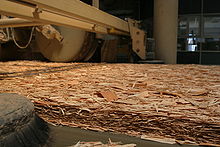- Oriented strand board
-
Oriented strand board, also known as OSB (UK) and SmartPly (UK & Ireland), is an engineered wood product formed by layering strands (flakes) of wood in specific orientations. In appearance, it may have a rough and variegated surface with the individual strips (around 2.5 by 15 cm (approx. 1 in by 6 in) each) lying unevenly across each other.
Contents
Uses
•Furniture •Construction
Manufacturing
Oriented Strand Board is manufactured in wide mats from cross-oriented layers of thin, rectangular wooden strips compressed and bonded together with wax and resin adhesives (95% wood, 5% wax and resin). The layers are created by shredding the wood into strips, which are sifted and then oriented on a belt or wire cauls. The mat is made in a forming line, the layers are built up with the external layers aligned in the panel's strength axis with internal layers cross-oriented. The number of layers placed is determined partly by the thickness of the panel but is limited by the equipment installed at the manufacturing site. However individual layers can also vary in thickness to give different finished panel thicknesses (typically, a 15 cm layer will produce a 15 mm panel thickness). The mat is placed in a thermal press to compress the flakes and bond them by heat activation and curing of the resin that has been coated on the flakes. Individual panels are then cut from the mats into finished sizes. Most of the world's OSB is made in the United States and Canada in large production facilities. The largest production facilities can make over a billion square feet of OSB per year.[citation needed]
Production
In 1980, North American OSB panel production was 751 million square feet (3/8" basis) (0.7 million cubic metres)[citation needed]. By 1990, this figure was 7.6 billion square feet (7.0 million cubic metres)[citation needed]. In 2005, this figure had grown to 25.0 billion square feet (22.1 million cubic metres).[citation needed] Combined European and Latin American production in 2005 was 3.5 billion square feet (3 million cubic metres).[citation needed]
In 2001, 19.4 million m³ of OSB panel was produced in the United States. The U.S. is Canada's largest OSB market, receiving 98% of its export product in 2005.[1]
Properties
Different qualities in terms of thickness, panel size, strength, and rigidity can be imparted to the OSB by changes in the manufacturing process. OSB panels have no internal gaps or voids, and are water-resistant, although they do require additional membranes to achieve impermeability to water and are not recommended for exterior use. The finished product has similar properties to plywood, but is uniform and cheaper.[2] When tested to failure, OSB has a greater load bearing capacity than milled wood panels.[3] It has replaced plywood in many environments, especially the North American structural panel market. The most common uses are as sheathing in walls, floors, and roofs.
While OSB does not have a continuous grain like a natural wood, it does have a specific axis of strength. This can be seen by observing the alignment of the surface wood chips. The most accurate method for determining the axis of strength is to examine the ink stamps placed on the wood by the manufacturer.
All wood-based structural use panels can be cut and installed with the same ease and types of equipment used with solid wood.
Some manufacturers may treat the wood chips with various borate compounds which are toxic to termites, wood boring beetles, molds, and fungi, but not mammals in applied doses.
Environmental impact
There is some debate over the environmental impact of OSB.[not specific enough to verify] The OSB manufacturing process allows producers to use tree species such as aspen or poplar as standard veneer plywood or lumber. The production method of OSB uses almost all the wood of the harvested trees, and small, young trees and faster growing species can be used. Due to the type of resins used, wood-based structural-use panels like OSB emit very low levels of formaldehyde.[further explanation needed] Emission levels of formaldehyde have been found to be not more than 10% of the criteria[clarification needed] of key national standards.[4]
See also
- Fiberboard
- Glued laminated timber
- Hardboard
- Masonite
- Medium-density fibreboard
- Particle board
- Plywood
- Pressed wood
- waferboard
References
External links
Categories:- Composite materials
- Engineered wood
Wikimedia Foundation. 2010.

